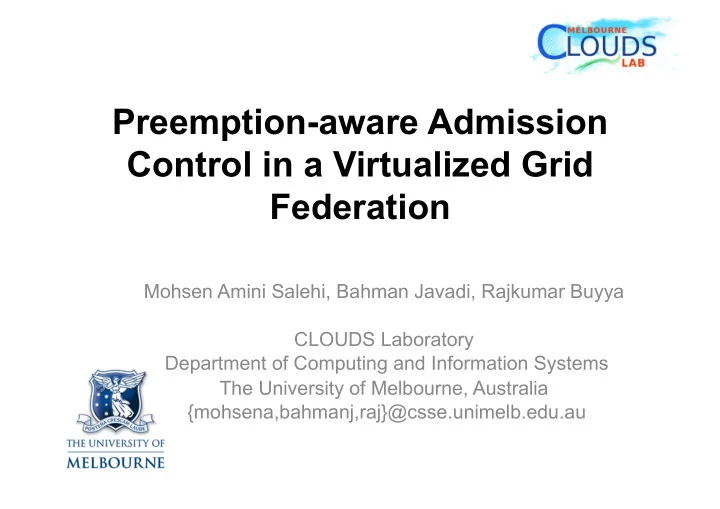

Preemption-aware Admission Control in a Virtualized Grid Federation Mohsen Amini Salehi, Bahman Javadi, Rajkumar Buyya CLOUDS Laboratory Department of Computing and Information Systems The University of Melbourne, Australia {mohsena,bahmanj,raj}@csse.unimelb.edu.au
Introduction: InterGrid • Provides an architecture and policies for inter- connecting different Grids. • Computational resources in each Grid are shared between grid (External) users and local users. • Local users have preemptive priority over external users! 2
Contention between Local and External (Ext.) users • Why contention happens? – Lack of resource (oversubscription of resources) • Solution for Contention: – Preemption of Ext. requests in favor of local requests • Preemption increases the response time and leads to deadline violation for Ext. requests. 3
Research Question • Deadline violations is because of over- subscription to the ext. requests. • Resource owners tend to accept as many ext. requests as possible. • The question that arises is: – What is the ideal number of ext. requests a cluster can accept in a way that: • The number of accepted ext. requests is maximized • Deadline violation is avoided
Our approach: Using Admission Control.
Problem Statement • What is the optimal queue length ( K j ) for ext. requests for in cluster j ? – Analytical modeling of preemption for ext. requests in a cluster.
Analytical Model • Our primary objective function is: • Assume that overall run time of an ext. request is ω , and encounters n preemptions before getting completed, then service time is: • Arrival rate of local requests ( λ j ) follows Poisson distribution, so n follows Gamma distribution:
Analytical Model(2) • We assume that local requests follow M/G/1 model, then: • The average waiting time of external requests in the M/G/1/K queue is: We have to figure out ρ j e and P j d,k • ρ j e is the queue utilization for external requests:
Analytical Model(3) • P j is the probability that a newly arriving d,k external request encounters k requests waiting in the queue of cluster j:
Analytical Model(4) • b j (t) is the probability density function (PDF) of service time for ext. requests. • Gong et al. 1 prove the service time of ext. requests with preemption follows the Gamma distribution. • Based on Gamma distribution: 1. L. Gong, X.-H. Sun, and E. Watson. Performance modeling and prediction of nondedicated network computing. IEEE Transactions on Computers,, 51(9):1041 – 1055, sep 2002.
Preemption-aware Admission Control Policy (PACP) for cluster j
Performance Metrics • We define D (average deadline of ext. requests) as: – rate l is the proportion of low-urgency ext. requests and u l , u h are the deadline ratios . • Deadline Violation Rate (DVR): • a and r are percentage of accepted and rejected requests. v is the deadline violation ratio. • Completed External Requests.
Experimental Setup • We use GridSim for simulation • 3 clusters with 64, 128, and 256 nodes and different computing speeds (2000, s2=3000, s3=2100 MIPS) • Conservative Backfilling for cluster scheduling. • Grid Workload Archive (GWA) is used to generate 2 days of bag-of-tasks requests.
Baseline Policies • Conservative Admission Control Policy (CACP): – Admits as many requests as assigned by the IGG (queue length is infinite). • Aggressive Admission Control Policy (AACP): – Each cluster accepts one external request at any time and tries to meet the deadline. • Rate-based Admission Control Policy (RACP): – Queue length is determined based on the service rate for external requests and local request arrival rate in a cluster.
Deadline Violation Rate (DVR)
Completed External Requests
Conclusion and Future Work • We explored the ideal number of ext. requests that a cluster can accept without violating deadlines in a federated Grid. • We developed a performance model based on queuing. • Experimental results indicate that the PACP decreases the deadline violation rate up to 20%. • PACP leads to completing more ext. requests (up to 25%). • In future, we plan to relax the assumption of moldable applications and solve the problem for all types of parallel requests.
• Any Question?
Recommend
More recommend